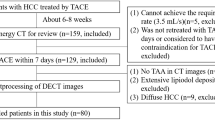Abstract
Objective
To evaluate dual-energy spectral CT imaging in evaluating the degree of differentiation in colon cancer.
Methods
Forty-seven colon cancer patients underwent spectral CT during arterial phase (AP) and portal venous phase (PP), and were characterized pathologically differentiated to well-differentiated (A, n = 18) and poorly differentiated or undifferentiated carcinoma group (B, n = 29). Lesion iodine concentration (IC) was measured and normalized to that of aorta (NIC). CT numbers were measured and the slope (λ HU) of the spectral HU curve was calculated. These parameters were statistically compared between the two groups. ROC curves were used to evaluate their diagnostic efficacies.
Results
There were significant differences in IC (1.01 ± 0.20 vs. 1.59 ± 0.57 mg/ml), NIC (0.12 ± 0.03 vs. 0.19 ± 0.09), λ HU (1.41 ± 0.29 vs. 2.03 ± 0.85), and CT number at 70 keV (48.61 ± 9.03HU vs. 63.97 ± 15.86HU) between groups A and B in AP (p < 0.05), but no difference in PP. Using IC = 1.13 mg/ml in AP as the threshold, one obtained a sensitivity of 81.8% and a specificity of 71.4% for differentiating well-differentiated from poorly differentiated or undifferentiated carcinoma. These values were statistically higher than those (64.7% and 62.3%) using CT number at 70 keV.
Conclusion
Spectral CT imaging parameters (IC, NIC, and λ HU) in AP provide improved accuracy for evaluating the degrees of differentiation in colon cancer than CT number at 70 keV.




Similar content being viewed by others
References
Segnan N, Patnick J, von Karsa L (2010) European guidelines for quality assurance in colorectal cancer screening and diagnosis. 1st edtion. European Commission, Brussels: World Health Organization, 16-17.
Jemal A, Bray F, Center MM, et al. (2011) Global cancer statistics. CA Cancer Clin. 61:69–90
Gollub MJ, Schwartz LH, Akhurst T (2007) Update on colorectal cancer Imaging. Radiol Clin N Am. 45(1):85–118
Linuma G, Miyake M, Arai Y, et al. (2008) CT colonography—towards applications for colorectal cancer screening. Asian Pac J Cancer Prev. 9(4):833–840
Hansen J, Jurik AG (2009) Analysis of current practice of CT examinations. Acta Oncol. 48(2):295–301
Matsumoto K, Jinzaki M, Tanami Y, et al. (2011) Virtual monochromatic spectral Imaging with fast kilovoltage switching: improved image quality as compared with that obtain with conventional 120kVp CT. Radiology 259(1):257–262
Zhao LQ, He W, Li JY, et al. (2011) Improving image quality in portal venography with spectral CT imaging. Eur J Radiol. 81(8):1677–1681
Lv P, Lin XZ, Li J, et al. (2011) Differentiation of small hepatic hemangioma from small hepatocellular carcinoma: recently introduced spectral CT method. Radiology 259(3):720–729
Zhang XF, Lu Q, Wu LM, et al. (2013) Quantitative iodine-based material decomposition images with spectral CT imaging for differentiating prostatic carcinoma from benign prostatic hyperplasia. Acad Radiol. 20(8):947–956
Broders AC (1921) Squamous-cell epithelioma of the skin: a study of 256 cases. Ann Surg. 73:141–160
Potretzke TA, Brace CL, Lubner MG, et al. (2014) Early small-bowel ischemia: dual-energy CT Improves conspicuity compared with conventional CT in a Swine model. Radiology 275(1):119–126
Takahashi N, Vrtiska TJ, Kawashima A, et al. (2010) Detectability of urinary stones on virtual nonenhanced images generated at pyelographic-phase dual-energy CT. Radiology 256(1):184–190
Pache G, Krauss B, Strohm P, et al. (2010) Dual-energy CT virtual noncalcium technique: detecting posttraumatic bone marrow lesions—feasibility study. Radiology 256(2):617–624
Linder JD, Geenen JE, Catalano MF (2006) Cyst fluid analysis obtained by EUS-guided FNA in the evaluation of discrete cystic neoplasms of the pancreas: a prospective single-center experience. Gastrointest Endos. 64:697–702
Lin XZ, Miao F, Li J, et al. (2011) High-definition CT Gemstone spectral imaging of the brain: initial results of selecting optimal monochromatic image for beam-hardening artifacts and image noise reduction. J Comput Assist Tomogr. 35(2):294–297
Boll DT, Patil NA, Paulson EK, et al. (2010) Focal cystic high-attenuation lesion: characterization in renal phantom by using photon-counting spectral CT-improved differentiation of lesion composition. Radiology 254(1):270–276
Zhang D, Li X, Liu B (2011) Objective characterization of GE discovery CT750 scanner: gemstone spectral imaging mode. Med Phys. 38(3):1178–1188
Johnson TR, Krauss B, Sedlmair M, et al. (2007) Material differentiation by dual energy CT: initial experience. Eur Radiol. 17(6):1510–1517
Iannaccone R, Laghi A, Passariello R (2004) Multislice CT angiography of mesenteric vessels. Abdom Imaging 29(2):146–152
Du JR, Jiang Y, Zhang YM, et al. (2003) Vascular endothelial growth factor and microvascular density in esophageal and gastric carcinomas. World J Gastroenterol. 9(7):1604–1606
Weidner N (2004) The importance of tumor angiogenesis: the evidence continues to growth. Am J Clin Pathol 122(5):675–677
Kim SJ, Lee KK, Kim DG (2010) Tumor size predicts the biological behavior and influence of operative modalities in hepatocellular carcinoma. Hepatogastroenterology. 57:121
Pang LF, Zhang H, Lu W, et al. (2013) Spectral CT imaging of myocardial infarction: preliminary animal experience. Eur Radiol. 23(1):133–138
Ej Moding, Clark DP, Qi Y, et al. (2013) Dual-energy micro-computed tomography imaging of radiation-induced vascular changes in primary mouse sarcomas. Int J Radiat Oncol Biol Phys. 85(5):1353–1359
Sahani DV, Kalva SP, Hamberg LM, et al. (2005) Assessing tumor perfusion and treatment response in rectal cancer with multisection CT: initial observation. Radiology 234:785–792
Acknowledgments
The authors would like to thank Dr Jianying Li and Dr Yun Shen for excellent technical support and for critically reviewing the manuscript.
Author information
Authors and Affiliations
Corresponding author
Ethics declarations
Funding
No funding was received for this study.
Conflict of interest
The authors declare that they have no conflict of interest.
Ethical approval
All procedures performed in studies involving human participants were in accordance with the ethical standards of the institutional and/or national research committee and with the 1964 Helsinki declaration and its later amendments or comparable ethical standards.
Informed consent
Informed consent was obtained from all individual participants included in the study.
Rights and permissions
About this article
Cite this article
Chuang-bo, Y., Tai-ping, H., Hai-feng, D. et al. Quantitative assessment of the degree of differentiation in colon cancer with dual-energy spectral CT. Abdom Radiol 42, 2591–2596 (2017). https://doi.org/10.1007/s00261-017-1176-6
Published:
Issue Date:
DOI: https://doi.org/10.1007/s00261-017-1176-6




